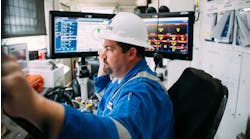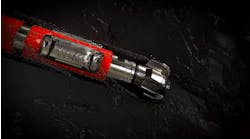Satellite communications key to cost-effective support of remote operations
Eugene Nathan
Baker Hughes Inteq
By centralizing data collection and distribution into a common support facility, specific location centers can facilitate the distribution of time-critical decision data to experts independent of location or time zone.
Using satellite communications to transfer real-time rig site data to office-based experts is not a new concept within the E&P industry. In 1985, Mobil established a satellite communications network to feed real-time drilling and MWD data to the Mobil Drilling Data Centre and, a short while later, Amoco opened a similar drilling center. These early command centers delivered rig site data to a central group of experts (additional to the core operations/asset teams) tasked with supporting critical operations. One of the challenges for these early centers was the question of how to justify the cost of maintaining dedicated experts and infrastructure in a changing business environment. As a result of this scrutiny, the Amoco center eventually disbanded in 1989.
Results of restructuring
Since then, the E&P industry has experienced some major structural changes fueled by the pressure to drive down costs and increase profitability. One result of this restructuring is that, as the industry finds methods of leveraging technological advances to allow for more efficient work practices, there are far fewer personnel employed both by operators and service companies. Additionally, the industry is populated by an ageing workforce. Concurrent with this loss of expertise is the growing complexity of operational technologies and a shift in activity focus to remote, high-cost areas of operation.
Beginning in the mid 1990s, rapid advances in telecommunications and computing technology have made real-time data transfer from the well site both more reliable and more cost effective. In Norway, Baker Hughes' Team2000 initiative, later commercialized as the Baker Expert Advisory Center/Operations Network (Beacon), was the first service company initiative to exploit these advances — bridging the gap between technological and organizational development. While the Norwegian Beacon center leveraged fiber optic communications to reduce rig site headcount, a key concept contributing to the center's success was that it made expert assistance available to operations "on demand."
null
Struggling for acceptance
The current trend of establishing third party operation centers within oil companies' facilities is struggling to gain widespread acceptance as operators attempt to justify the costs. These costs include both establishing an in-house center and dedicating valuable expertise to support a single or limited number of operations. Although it is possible for operators to justify the addition of dedicated personnel to support ad-hoc "critical" wells, this cost burden is unsustainable when maintained across periods when expert assistance is not required. Because of this, oil companies and service providers are struggling to find new methods of providing expert assistance in the current E&P business environment.
Recently, Baker Hughes began supporting operations for multiple operators with "on demand" expertise. The elements of the concept consist of:
- Reliable rig-to-office communication of real-time decision data – typically drilling, MWD/LWD, mud logging, wireline and completions data
- Central physical location, independent of specific oil company facilities, for the collection and distribution of data
- Secure Web-based distribution applications supplying geographically dispersed subject matter experts with time critical data
- Open computing standards.
Rig-to-office communications
Today, real-time drilling data is moved from the rig site to the office using a number of technologies, including landlines, microwave transmission, and fiber optic technology. However, satellite communications are playing an ever-growing role, thanks to the combination of remote drilling environments, increased reliability, and the dropping cost of satellite bandwidth as more systems are deployed. These satellite telecommunication vendors can provide not only Ku- or C-band rig-based hardware, but also bandwidth, maintenance, 24/7 support, teleport, and secure network connections through well site-to-Web portals. Data can be transmitted via existing rig-based communication infrastructure if bandwidth is available. A cost effective method of moving real-time data from the rig is as a "second carrier." As an alternative to providing stand-alone satellite systems, rig data can "piggyback" onto an existing satellite system, where the only additional cost is the increase of bandwidth capabilities.
Expert advisory centers
To make optimal use of expertise, it is important that key individuals have access to critical data sets and expert resources regardless of their physical location or time zone constraints. While drilling a well, a specific competency may only be required for a limited period of time. If these individuals have remote access to critical data sets, operational performance can be improved without dedicating expensive resources to a specific operation or location.
This is the rational behind Baker Hughes' Houston-based center that receives data streams from numerous global locations and a multitude of clients – permitting experienced engineers to oversee daily operations, provide a first point of contact for technical assistance, control the quality of data, and distribute data to end users. If the center's staff is unable to resolve a problem within 15 min, the issue is handed off to internal subject matter experts.
This dispersed expertise can be accessed to enhance operational performance and service quality. Oil company expertise, in the case of a global client, may be located in any geographical location, and subject experts may only be required to assist with a specific operation or problem.
null
null
As well as providing an additional level of quality control and troubleshooting, these centers can also streamline the launch of new technologies. Today, engineers can monitor multiple test runs from a single location and can even communicate directly with the tools to troubleshoot.
Web-based data
A secure Internet-based service that uses common Web browser technology to provide access to real-time and archived decision data to the client and service company's home or office environments is critical to supporting remote operations. Not only is data accessible from anywhere, but also users are able to use a system that requires little or no training and no installation of proprietary software. Available data sets can include real-time MWD/LWD data, drilling displays, and data gathered through surface sensors or third-party feeds, as well as archived data. Based on the client's wishes, user access can be restricted to specific wells, data type, reports or logs.
Remote operations in Angola
BP drilled a deepwater wildcat off Angola in late 2003. The BP asset team was located in Sunbury, UK, while the operations team was based in Luanda. The well's data acquisition program included two planned core intervals and an extensive wireline program to acquire image data, pressure data, and various other formation evaluation parameters. Because of this, core point determination was deemed critical and it was important that the asset team participate in determining the optimal core points.
To ensure that BP had real-time access to the information they needed to make these critical decisions, a remote satellite network connection was established at the rig site. The Beacon center in Houston managed the real-time satellite feed and distributed data to accredited users including BP and BHI operational personnel in Luanda, as well as members of BP asset team in Sunbury and Baker Atlas personnel located in London and Houston.
Accessing the rig site LWD over the secure Internet connection, BP's Sunbury-based geologists were able to review the data to pick the optimal core points. And, as the data could be reviewed without requiring proprietary software, the second core point was picked from home during a weekend without having to call personnel into the office.
Baker Atlas personnel in Houston also used the real-time feed to monitor their RCI tool's formation pressure tests and sampling. Based on the rig site data, these experts consulted with the rig site engineers on the tool's downhole stabilization to ensure accurate test results. On a previous well, this Web-enabled interaction proved critical when unexpected RCI pressure responses were discussed using experts around the world in real-time. This unique collaboration enabled the rig site operations team to exclude the possibility that a tool malfunction was responsible for the measurements – saving valuable rig time by not swapping out the downhole tool.
Because the Angola well was being drilled during December the system enabled key personnel to have greater flexibility to maximize family time by viewing data from home while maintaining integrated team performance by having multiple home/office-based staff connected at once. To avoid delays, the well's image data were transferred to geoscience experts in Algeria for timely processing during the UK/US holiday period. Once processed, accredited users who were on holiday could access these logs and other well site data with nothing more than a standard 33K dialup Internet connection.
Cost-effective model
In the face of continuing consolidation within the E&P industry, the need to develop more efficient work processes becomes increasingly important. The shedding of industry personnel places an ever-greater burden on both operators and service companies to use expert resources in the most effective manner possible.
By centralizing data collection and distribution into a common support facility, location centers can facilitate the distribution of time-critical decision data to experts independent of location or time zone. And without the need for operators to build and staff their own internal operation centers.
Satellite communications play a vital role by allowing the transmission of real-time data from remote rig-sites – providing an additional layer of expert support for these high-cost operations.
Author
Eugene Nathan is the product line manager of surface systems for Baker Hughes Inteq in Houston.
References
Booth J.E., Herbert II, J.W.: "Support of Drilling Operations Using a Central Computer and Communications Facility With Real-Time MWD Capability and Networked Personal Computers," SPE 19127
Foreman, R.D.: "The Drilling Command and Control System," SPE 14387
Ronalds, B.F.: "A New Degree Program in Oil and Gas Engineering," SPE 77579
Wahlen, M., Sarawyn, S., Smith, R., Blaasmo, M.: "Improving Team Capability and Efficiency by Moving Traditional Rig-Site Services Onshore," SPE78336






